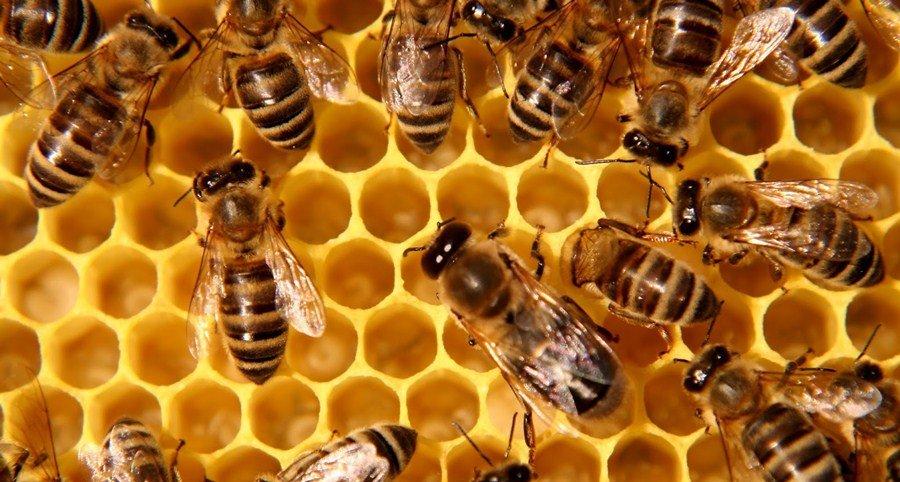LOOK around… you will see that the world is filled with the most amazing and beautiful creations of Allah. Let’s explore them and astound ourselves with one of the tiny creatures existing, breathing and flourishing on this land of ours. Come and take a tour of the beehive, and prepare to be amazed!
Allah says:
“ and your Lord inspired the bee, ‘take for yourself among the mountains, houses, and among the tress and that which they construct. Then eat from all the fruits and follow the ways of your Lord laid down (for you)’. There emerges from their bellies a drink, varying in colors, in which there is healing for people. Indeed in that is a sign for people who give thought.” [Surah Nahl, 16:68-69]
We find bees on mountain or tree tops or on buildings, just as the ayah mentions. These yellow and black creatures are just 0.4 to 0.6 inches long, but they carry out the most extraordinary work with the greatest efficiency and precision.
Like humans, honey bees are social creatures and live in colonies. How many? Take a guess… 1000? No…3000? No again. You would find 20,000 to 80,000 bees living in a single hive! It seems like bees are doing a better job of keeping family ties than us humans.
Let’s get to know the members of the bee family: the queen, drones and workers.
The Mother of the Hive
The queen is the mother of all bees living in the hive, and the only fertile bee in the hive. A queen can live upto 5 years, unlike the other bees who die out in 4 to 6 weeks.
The queen does only one job her entire life, that is laying eggs. She lays up to 2000 eggs per day! Like, any other queen, the queen bee is surrounded by her servants who serve her day and night. These are the worker bees that are always at hand, feeding her, cleaning and protecting her.
How do you think the queen bee shows her authority and queenship over the other bees, and brings about law and order in the hive? With a special bee perfume. Yes, you read that right. The queen bee continually emits pheromones, a chemical also known as bee perfume, that only the bees in the hive can smell. These pheromones keep the female workers sterile and also act as a signal to assure all the bees in the colony that the queen is alive and all is well in the hive. Not only that, but every hive has its own distinct scent, hence distinguishing them from other bee colonies.
Once the queen bee gets old, there is a reduction in the production of the eggs as well as the bee perfume, which is a sign well understood by the worker bees. Without wasting any time, they all set to work and make new royal cells or queen cups, and feed the egg or any existing larvae royal jelly till it comes out of its cell (and even after that), which then becomes the upcoming queen of the hive.
The Workers
These bees are female and sterile, and are the most hardworking members of the hive. They do each and every work in the hive from the minute they emerge from their cells.
The worker bees are responsible for numerous tasks, like cleaning the hive, caring for the larvae and the young, feeding the queen and the drones, making honey, building and maintaining the combs, hive ventilation and security, gathering and storing nectar, pollen, water and resin.
The buzzing sound of a honey bee comes from the beating of their wings upto 200 times per second, while flying at a speed of around 25 km per hour.
Going from one flower to another collecting nectar and pollen is tiresome, but what would happen if the bee kept going back to the same flower? This doesn’t happen because a honey bee leaves a scent on a flower that it has already extracted nectar from, indicating to other bees that the particular flower was already checked in.
You can see a flower? A bee can smell a flower. Each bee has 170 odor receptors, which means they have one serious sense of smell! Their sense of smell is so precise that it could differentiate hundreds of different floral varieties and tell whether a flower carried pollen or nectar from meters away. They use this to communicate within the hive also.
A bee has five eyes! The worker bee’s eye is a very complex organ with 6,900 facets, known as ommatidia, each carrying out separate visual processes. A worker bee can solve harder and complex mathematical problems that can keep computers busy for days! Even though its brain is the size of a grass-seed, it can calculate foraging distances and energy expenditure, and find out the shortest route to the targeted flowers.
Eyesight – good. Olfactory system – good. Memory – good. One problem though: honey bees are deaf. So how do they communicate?
To say simply, they communicate through dancing. They share information about the best food sources by performing their ‘waggle dance’. When the worker returns to the hive, it moves in a figureof- eight and waggles its body to indicate the direction of the food source, the flying time to the sources, and even the wind speed!
The worker bee collects nectar from the flower, swallows it, which then undergoes a chemical change in its stomach, where it becomes a heavy, sugary liquid rich in vitamins and minerals. Later, bees place it into the honeycomb cells and seal it with a wax cover. The honey acquires its familiar taste and consistency in the comb, thanks to the special air-conditioning provided by the bees.
That’s not it, the worker bees are superb engineers also. One of the most amazing things about bees are the identical, exceptionally regular hexagonal comb cells, they make out of beeswax, which is secreted from their bodies. This offers yet another indication of the superior intelligence manifested in bees. They also construct a large number of cells. For example, in order to store 9.9 kilogram (22 pounds) of honey, bees need to build a comb of 35,000 cells.
The Lazy Bee
Drones, are the only male bees in the hive and possess almost none of the features found in other bees, except for their reproductive organs, They are not able to serve any other purpose other than fertilizing the queen.
Despite the male bee’s lack of abilities, the workers take great care of them until they mate with the queen. Five or six workers need to work non-stop to feed just one of the 400 to 500 male bees in the hive.
The male bees leave the hive and start looking for the queen some two weeks after they emerge from their cells. The queen and the male generally meet at high altitudes. Males live only in spring and early summer, after which they are killed by the workers. Once the time of the mating flight is over—and as the nectar levels in flowers start to decline in the heat of summer—the workers’ behavior towards the males changes completely. They are either killed or expelled out of the hive.
Even a small insect like a honey bee, is just not a mere insect, but a perfected creature of Allah that was created with a purpose and goal that lies in the wisdom of Allah.
And in your creation and all the creatures He has spread about there are signs for people with certainty. [Surah al-Jathiyya 45:4]








 Dr. Bilal Philips
Dr. Bilal Philips